Marginella pseudosebastiani Mattavelli,
2001.
Statements
on the "Complex", with particular respect to
Marginella sebastiani Marche-Marchad & Rosso, 1979.
Archives, 2006.
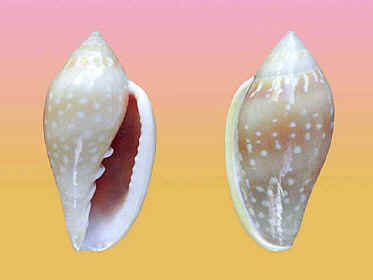
Marginella pseudosebastiani, recto & verso, 47,3 mm length, sintype.
Introduction. In 2001, on the basis of 30 sintypes about, a new species has been
described as Marginella pseudosebastiani
[Flavio Mattavelli, Malacologia Mostra Mondiale (magazine, via Adriatica
Nord, 240 - 63012 - Cupra Marittima - AP - Italy),
n°34, September 2001, pages
03-08, only in Italian language]. The species
was located in Mauritania, 60-90 m depth.
Owing
to shell affinity, the species Marginella
glabella (Linneus 1758), Marginella
sebastiani Marche-Marchad
& Rosso 1979 and Marginella pseudosebastiani were included in a "(Marginella) glabella & sebastiani
Complex", linking to the Complex M. desjardini
Marche-Marchad 1957, M. goodalli
Sowerby 1825, M. irrorata
Menke 1828 and the "hybrid forms".
The
terms “hybrid” and “albino” were used, and are used
only with a morphological purpose.
Comparative
description. In
order to distinguish M. pseudosebastiani
it is essential to notice the simultaneous presence of several evident
morphologic features:
- length 40/64 mm (min/max. length of my 30 homogeneous sintypic
specimens of new species)
- dark brown bend always present under the suture, always with very evident
whitish axial subsutural flames (these axial flames are always clear in M.
glabella & M. desjardini too, but not in M.
sebastiani Marche-Marchad
& Rosso 1979: it is important to note that true M.sebastiani
can show axial subsutural whitish small flames, that however in many cases
are not clearly evident, or even absent in most forms related to its holotype)
- very light carnation pink bottom colour (the bottom colour of M. pseudosebastiani is lighter than typical M. sebastiani)
- two evident dark bends only on the body whorl (the dark bends of M. pseudosebastiani are always less evident than the dark
bends of M. desjardini, and those of M. pseudosebastiani are always more evident than those of
typical M. sebastiani)
- several whitish spots, about 1-2 mm diameter, clearly spread in a large
quantity on the body whorl, generally without superposition, sometimes aligned
(these spots are smaller and more numerous than the relatively few marks of the
typical M. sebastiani, that is studded with
big punctiform marks, 2-3 mm diameter about; besides
on M. pseudosebastiani the spots are never
very close and confused as on M. glabella, where the spots are mostly superimposed)
- on M. pseudosebastiani (but also in M. sebastiani) you can find some spots also in light
bends, which never happens in M. desjardini,
where the marks, often changed into light long marks, can be found only in the
area of the dark bends
- the shape of shell of M. pseudosebastiani is
usually lengthened nearly as in M. desjardini,
little more than in M. sebastiani, much more
than in M. glabella (but some small specimens of M. pseudosebastiani can be confused with special
forms of M. glabella)
- whitish margin inner side with feeble crenation from 0 till
19 denticles never striking (often there are tracks
of denticles distributed along the whole margin),
never concentrated (on the contrary the denticles are
sinusoidally protruding and concentrated in the adult
specimens of M. desjardini).
You
must not consider a single feature, but you must consider the whole of
them.
Gallery. In biology a species could be define also when it is not easily
distinguishable, and vice versa an animal can be distinguished but not biologicaly distinct from its similars.
I do not know the DNA test for M. pseudosebastiani, but it does not touch the high
“conch-logic” interest, especially at amatorial
level. Passion is above all stimulate when watching a shell the collector does
not succeed in morphologic classification. So the
ideas can change depending of the collector culture or knowledge, can he be a
lumper or a splitter more or less expert.
For this reason i decide to share this photo gallery.
Not all the pictures are mine,
some are taken from internet with a didactic purpose only for scientific
reasons.
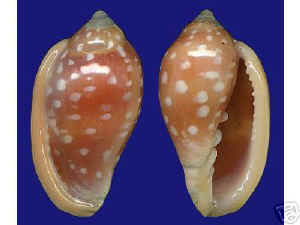
Marginella sebastiani, 42 mm length, almost “typical” morph, picture taken on a Singapore
site. In the buccal view note the crenated margin and
the “typical great” spotting of the livery (spotting already reduced in the
dorsal view).
Morphologic notes. Sometimes, to abbreviate, I indicate
Marginella pseudosebastiani as
P, and Marginella sebastiani as S. The margin of P usually is smoother
of S. However the presence of the dentation on the
margin alone is never determining for the identification. There are S with the
completely smooth margin.
It is difficult to separate P from S only by watching the dots of the shell. In my opinion the white spots (generally smaller in P) are not determining by themselves. The configurations of the dots sometimes do not show the "typical" configurations. There are atipical P with great dots.
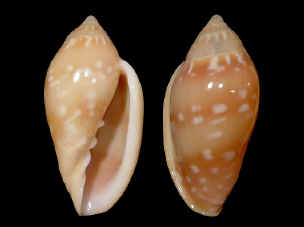
Atypic M. pseudosebastiani with wide spots, recto and verso,
picture taken on eBay with the wrong name of M. desjardini,
41 mm, trawled at 300 m, Mauritania. The nomenclature is incorrect because in M.
desjardini there are no spots in the light
stripes, instead in the picture spots are present (bigger than the typical M.
pseudosebastiani), of course without considering
the flash reflexes. Generally in M. desjardini
the dark stripes are darker, the over sutural pale stripe seams nearly white,
the lip is not smooth as in the picture.
The holotype of M. sebastiani
Marche-Marchad & Rosso 1979 had few very
great clear points. However there are also atypical M. sebastiani
with small and numerous clear points (which are similar to those of the
typical M. pseudosebastiani), as you see in
the following photo, where axial subsutural
flames are absent.
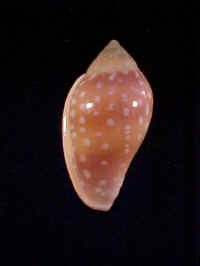
Atypical
M. sebastiani, with small and numerous clear
points.
The discriminating factor between P&S is the presence of white axial subsutural flames.
In M. pseudosebastiani they are always present
and are crammed and subparallel to the axis of the shell. In M. sebastiani they are usually
absent or, when they seldom appear, they are like isolated prolonged
stains.
The flames exist
commonly also in M. glabella, and in M. desjardini,
but these species are different from P &
S, for different patterns.
The real problem
is with intermediate specimens P & S, for example see picture in Harry G. Lee's section.
Also see the pictures
in Quick reference guide.
Distribution. The correct geographic distribution of molluscs is always
fundamental. I reconfirm that the distribution area of Marginella
pseudosebastiani is only "Mauritania",
as defined below. I found that confirmation is on line, in specialized Web
sites about West Africa shells (see links page).
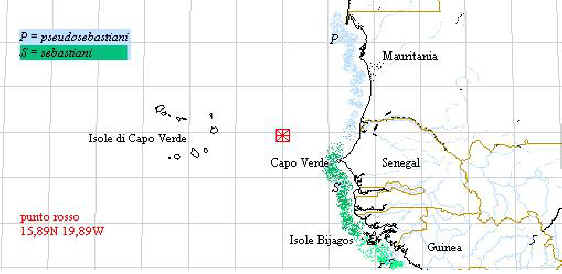
Senegal, or better Cap Vert, is a board line between two different marine
zoogeographic provinces:
1. In the North of Cap Vert an almost temperate area with
high salinity and cold sud-west currents; to semplify I
call this Senegal's portion "Mauritania", including true Mauritania
also.
2.
In the
South of Cap Vert an hotter region
with moderate salinity and warm sud-east currents ; I call this Senegal’s portion "Guinea",
I mean with Guinea Bissau and Guinea Conakry, also this “Guinea” is homogeneous
since Niger delta, that is the cause of a low water salinity, introducing a new
ecological boundary. Do not confuse this area with the Equatorial Guinea in the
South-East.
Marginella sebastiani can be found surely and
typically from South of Cap Vert as far as Conakry and Bissau "Guinea"
(not Equatorial Guinea), but specimens are found in South of
"Mauritania" also (Senegal, not including true Mauritania). Marche-Marchad & Rosso
chose as holotype of M. sebastiani a specimen
from Senegal (“Cap Vert Peninsula”), coloured,
without whitish subsutural axial flames, with wide light spots, shell not very
elongated, but with the buccal margin armed with a lot of denticles,
as many typical specimens of “Guinea”.
Incidentally, in Cap Vert Islands, species of the “glabella & sebastiani complex” are not found,
because of the too cold waters (Antonio Guerreiro,
personal comunication).
It should be
investigate also on the batimetric distribution of all the complex, but it is so hard!
Geographical discussion. On
the market today, M. pseudosebastiani is rarer
than M. sebastiani, but I believe that both
species live common, respectively the first in the temperate waters of
“Mauritania” and the second in the warm waters of “Guinea”, even if the living
area of M. sebastiani can be found in the
North of Senegal (to Mauritania), not with typical populations, but principally
with hybrids S & P, or presumable ones, as before in Harry G. Lee's section, for rare reverse coiled specimens.
There are also hybridations of S with M. glabella, and P with M. glabella.
P & S seam to be actually two “sister” species highly hybridable, without being the same biological species, and also not to be two geographical subspecies of the same
biological species. Note that, in case of P or S populations, every morphology,
extreme or intermediate, has a geographic location pratically
unic. P & S are the furthermost limits of a chain, that have no possibility of interbreeding between
themselves in most of cases. Where there is a species there is not the other,
generally; sometimes the intermediate rings can form “hybrid” populations (with
intermediate morphologial characteristics) of
homogeneous and fertile individuals; for this reason it is discussible to
define them as hybrids. Every single population actually presents
characteristics sometimes more P or more S, without raeching
the total mixing of the two morphology in all the individuals of the
population, in the same geographical area.
North of Cap Vert, with precision in Kayar,
there should be the biggest specimens of P, in simpatry
with M. desjardini (Marcel Pin, personal
communication; oddly, he spoke about some specimens called S, with the P
morphology instead). I cannot exclude also a
probable hybridation of P versus M. desjardini, north Cap Vert. This hybridation
could be the cause of the growth of the sizes of the shells of P.
On the other hand, as in the following picture, from e-Bay, there are hybridations
(but not hybridations of P) with M. desjardini also south Cap Vert. The provenience
of the big specimen, in e-Bay wrongly named: "Marginella
desjardini", 57mm, F++/Gem, Casamanche,
is south Cap Vert, but the specimen is not completely M. desjardini
(in M. desjardini there are no spots in the light stripes,
instead in the picture big spots are present, typical of S). It not could be a "hybrid" P/S for the
presence of sinusoidal protuberance of the lip, distinctive of M. desjardini.
 In my opinion (2006) it is a "hybrid" M. sebastiani/desjardini = S X D
In my opinion (2006) it is a "hybrid" M. sebastiani/desjardini = S X D
Nota
del 2020: lo spinoso argomento degli ibridi ibridogenici
= klepton, oppure delle vere specie, è tuttora
aperto.
Considerando
che nel 2012 è stata introdotta la nuova specie Marginella pseudodesjardini
Le Béon, 2012 = R, la foto a latere ne potrebbe
rappresentare un esemplare. Ciò non significa che ritengo S X D = R, bensì che
R è una vera “specie”, mentre l’identificazione (morfologicamente esatta)
dell’esemplare 57 mm = S X D potrebbe essere forse biologicamente errata.
Potrebbe anche essere R X S. Soltanto un’analisi genetica potrebbe dirimere la
questione dell’esemplare.
Note of 2020: the thorny topic of hybridogenetic hybrids = kleptons,
or true species, is still open.
Considering that in 2012 the new species Marginella pseudodesjardini
Le Béon, 2012 = R was introduced, the photo at
the side could represent a specimen of R. This does not mean that I consider S
X D = R, but I think that R is a real "species", while the
identification (morphologically exact) of the specimen 57 mm = S X D could
perhaps be biologically wrong. It could be R X S too. Only a genetic analysis
could solve the question of the specimen.
At the end, in “Guinea” are found only M. sebastiani, and in the South of Senegal the most
striking M. sebastiani (in my opinion because
of hybridations with the best M. desjardini, and sometimes with M. goodalli, instead in “Guinea” there should not be hybridations between P & S).
If P & S were
two flowing subspecies, statistically, a gradually intermediate mutant big
population shoul appear in a wide intermediate living
area, while actually there is a morphologic separation in two different big
population only with some hybrid population, or single hybrids, in the boundary
area between the 2 endemicity
zones. It is as there was a clepsydra-like distribution. By clepsydra distribution I
have deduced that P&S really are two different species.
“Albinos”. In M. glabella, "albinos"
sometimes are apparently common, little
size, stocky, in
determinate
places ("Mauritania"). On the contrary, I have not found albino
specimens that can be related to M. sebastiani or to M. pseudosebastiani
surely, but they could exist. I have notice this following picture of Roger
Le Béon about two marginellas
of the studied complex.
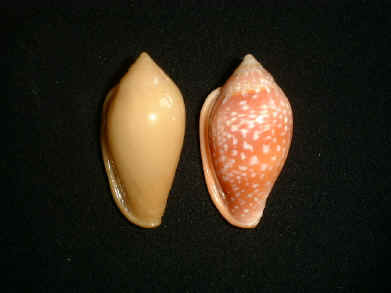
On the left an unique elongated specimen
completely with an uniform greenish straw colour, 54 mm length, Cote d'Ivoire
(!), 1,86 lengthening. The lengthening is like M. desjardini, but the shell outline looks like P/S. It
should be also a strange variety, in strange locality, of M. glabella,
species where albinos are known, also in shells not so
elongated as in P/S.
On the right another specimen of uncertain
nomenclature, perhaps a hybrid M.glabella/ M.sebastiani, or atypical M. sebastiani,
53 mm length, Sénégal, 1,79 lengthening, with too
little subsutural flames, coulored as M. sebastiani.
M. glabella is
certainly the species that presents greatest variability, generally associated
with a smaller size than P&S, and alternate in geographic distribution. See the
article "Universo
lumperia".
Geographic exceptions. I propose an interesting particular case, the “almost-albino” specimen n° 1488 of
the Web site FIRAMA.
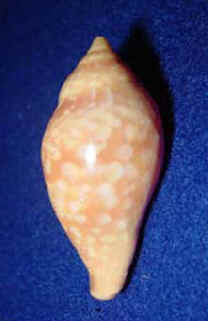
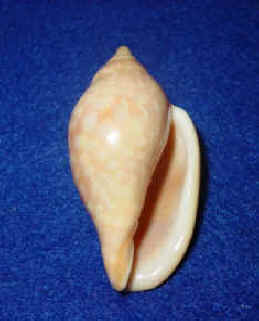
Specimen
n° 1488. The anomaly of the great clear spots, perhaps a tendency to albinism,
is no doubt the worthiest morphologic characteristic. So this specimen, 52 mm length, may be a very anomalous Marginella pseudosebastiani
or a true hybrid P/S. In my opinion this specimen
is rare, both for the morphology and the place of origin.
The most amasing biological
characteristic is that the shell seems to come from the Guinea Bissau, Geba River, trawled 50 m: it would be like finding a white
bear in Italy. It is possible a hybridation M.sebastiani/M.desjardini
too, but very strange morphologically: it is too clair, the outer lip is smooth, without sinusoidal
protuberance of the central denticles.
Conclusion.
In the "Complex", with M. desjardini, P&S and M. glabella, there are 4 basic morphologies which are different but between
themselves they are intermediate, as if the basic morphologies were set each at
the vertexes of a tetrahedron. Biological science today is based no longer on morphology, but without morphology not even Biology
can exist. How to identify the intermediate cases? It would be necessary to
find the soft parts of the molluscs, and, besides a direct anatomical
comparison, the scientist could make the DNA analysis, or some other
discriminating biological analysis. For shell collector the game could not
be worth the candle.
Dott. Ing. Flavio Mattavelli.
Via Serbelloni, 67
20064 - Gorgonzola - MI
- Italy.
E-mail: matta.a@tiscali.it Article of November 2006. Top.
|
In July 2020, the new species Marginella velai Ahuir Galindo & Tiziano Cossignani, 2020 was introduced in N° 108 of the magazine MMM
(Malacology World Show of Cupra Marittima, image
A). The specimens have average length of about 30 mm, locality of origin
Morocco. The species “velai” can be confused with some already known
species of Marginella glabella Complex, intended to include
Marginella irrorata
Menke,1828 and even Marginella lamarcki Boyer,
2004. In 2018 I had envisaged the
existence of another "species" Marginella
(kl.?) visayae, which can also be confused
with the previous species similar to M.
glabella & irrorata. In October 2021 I
confirmed Marginella (kl.?) visayae new "species" (N° 113 MMM magazine), an
article that can be enlarged by further details on the my
website. My study on “visayae” involved other "species" which can also be
linked above all to some varieties of M.
glabella.& M. irrorata. In addition, some "albino
varieties" now for me would become new "albino
species" (M. albida
& M. tizianica) of the Complex
studied, even if they require biological confirmation. These
"albinos" were supposed to be species only on the Internet. In April 2021, the new
"albino" species Marginella mattavellii Cossignani,
2021, had already been introduced in N° 111 of the magazine MMM. For all these novelties, also
doing a morphological
revision of the multifaceted M. glabella,
I wrote 6 Web pages, for which it is possible to set up a specialized
interactive assembly regarding the most
glabella-like & irrorata-like “species”.
For these, only in
Italian language, see at the bottom of the following index. General
home, 2022 (50 pages + 1
list). The site is divided into 4 Sections (Shells, Machines, Model
Aircraft, Gorgonzola). The sectional pages can be accessed by linking the Homes of the individual
Sections.
·
Introduction (only in Italian language) ·
Specie/klepton
Concepts,
2016 update. ·
Marginella pseudosebastiani Mattavelli, 2001. Statements
on the M. sebastiani & glabella Complex
(2006 archives, this page) ·
Atlante delle specie attuali del Marginella
glabella Complex e di
alcuni loro ibridi morfologici. 2022 update. ·
Marginella glabella & sebastiani Complex Atlas , ex quick reference Guide, 2022 update. ·
“La variabilità fatta specie” article (3 pages, 2005) to be revised
(only in Italian language), regarding M.
glabella, irrorata & visayae:
·
Other kleptons
in the Marginella glabella Complex? With photografic
table of the different hybrids & species. 2017
update. ·
Marginella pseudodesjardini Le Béon,
2012 new species, but which could be a remarkable klepton
instead. Notes on the different "pseudodesjardini
giselica" Mattavelli, 2013 form. ·
Universo lumperia.
Morphologic hybrids SXP and SXG. Possibility of the new M. (kl.?) pseudoglabella
Mattavelli, 2014 hypothesis. ·
“pseudoirrorata” 2017, variety of Marginella irrorata. ·
Complex links. 2020 release. Hypothesis of “pseudoglabella”, 2017, 2018 new species. ·
Links to Marginella glabella Complex, solo in italiano con postilla “La bocca
della verità”. Release 2020. ·
Nuovo sguardo ai mondi
di M. glabella e M. (kl.?) pseudoglabella
Mattavelli, 2018. ·
Descrizione comparativa
di Marginella (kl.?) pseudoglabella Mattavelli, 2018 new
species. ·
Marginella (kl.?)
visayae
Mattavelli, 2018, supposed new “species” or klepton
G X I, with “varieties” in the Complex: M. pseudoglabella
lellae & M. irrorata
pseudoirrorata. ·
Analysis of 5 confondibili marginelle simil-glabella. Release 18/02/2021. Please add this analysis to the M. glabella Complex etc. Atlas. Also add the novelties:
|
Il mio
sito a novembre 2022 è composto da 50 pagine (+ 1
elenco), raggruppate in 4 Sezioni, dalle cui singole Home pages potete risalire alle singole pagine sezionali:
·
Sez.
Conchiglie
(24 pagine), “specie” del Genere Marginella ricollegabili al Complex di M. glabella, irrorata, sebastiani, pseudosebastiani, desjardini...
·
Sez.
Macchine
(8 pag.). Panoramica di alcune macchine costruite
dalla ditta Cavalleri Mattavelli Sas.,
dove ho lavorato per oltre 40 anni.
·
Sez. Aeromodellismo
(16 pag. solo in italiano). Aeromodelli non convenzionali in cartoncino, canard
e tuttala, con studi di aerodinamica amatoriale.
·
Sez.
Gorgonzola
(2 pag. solo in italiano). Ampia monografia sulla
mia città dopo il 1990, con allegate alcune Chiacchere
di un conchigliologo.
Buona
navigazione, good navigation
Flavio
Mattavelli
